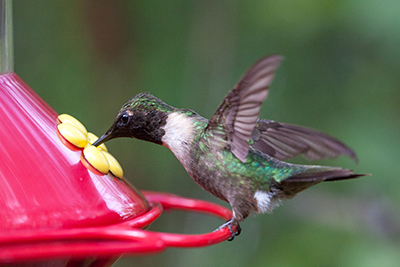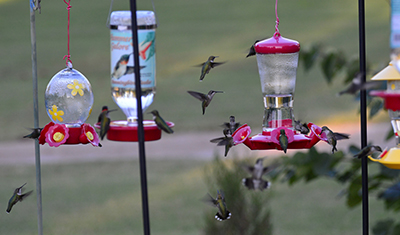
Audubon Adventures

Activities
 Activity 1
Activity 1
Birdwatching, Scientifically

 Teacher-Led Field/Classroom Activity
Teacher-Led Field/Classroom Activity
Science/Research/Math/Art/Writing
What can a bird feeder reveal about birds?

Objective
Students will formulate research questions, observe, and gather data in the manner of scientists pursuing a line of inquiry.
Students will need:
- Paper, pencils, pens, markers
- Field guides to regional birds
- Computer and Internet access
- Bird feeders located on school grounds, preferably outside classroom window (preferably a variety, such as tube feeders, suet feeders, nectar feeders; however, the activity will work fine with a single feeder)
- Reproducible “Bird Feeder Study Data Sheet,” one per student for each feeder used in the study
Suggested time:
Multiple class periods as needed for observation; two or more periods for preparing and sharing data
What to do:
- Before involving your students in this activity, take time to explore Audubon’s “Hummingbirds at Home” website. This community-science project explains how to observe a patch of flowers and record data about it for sharing with scientists and other participants. It also provides useful tips about watching birds and identifying them. If you live in an area that is visited by hummingbirds and are attempting this activity in a season when they will be present, consider involving your class in Hummingbirds at Home, too.
- Ask students what they know about birds and their feeding habits. What kinds of birds have they seen? What do birds eat? Do any students have bird feeders set up at home? What would they like to know about birds’ feeding behaviors? Tell students they will be observing bird feeders on the school grounds over the next few weeks in the manner of professional scientists studying birds. They will devise a question to research, make regularly scheduled observations, gather information and data, and then analyze and present what they have learned.
- Distribute copies of the downloadable reproducible, “Data Sheet: Bird Feeder Study.”
- Together, brainstorm a list of research questions to pursue during feeder observation. For example: What kinds of birds visit bird feeders? How might different kinds of seeds or seed mixtures affect what birds visit the feeders (e.g., millet mixes versus sunflower seeds only)? If you have more than one type of feeder, do certain kinds of birds prefer a particular type of feeder? Do certain birds “hog” the feeders and keep others away? How does temperature/weather affect feeder use? When do birds tend to visit the feeders most—morning, midday, or afternoon? As a class, choose a question to pursue and discuss how to proceed.
- Before starting, have students look at regional field guides to get an idea of what species of birds they might expect to see in their area.
- Once the feeders have been set up, students can draw and describe them in their data sheets.
- Have students observe the feeders daily at set times. Lead them to understand that observing the feeders at the same times each day is important because only one aspect of a study should be changed at a time while others remain consistent. The aspect that changes is called the variable. For example, students might set up a pair of feeders in the same location, with one containing millet mix and the other sunflowers only; these would be checked together at the same time each day. Alternatively, if students want weather to be the sole variable, both feeders would contain the same kind of seed.
- Students record their observations on their data sheets (how many birds they counted, what kinds, what the weather was, which feeders the birds were on, and the like). Keep a running list of the birds they’ve identified at the feeders.
- At the end of the period of study, have students graph their results. For example, if they were seeking to find out when feeders were most popular with birds, their graph would feature time of day as one axis and number of birds observed as the other axis. They might use Excel or other programs to create graphs or charts. The study can also be summarized in a PowerPoint presentation.
- A study of birds at bird feeders can be extended across months or even the whole school year, if desired (even if it consists only of identifying birds that visit the feeders in different seasons). In addition to Hummingbirds at Home, online community-science projects that invite participation by entering observation data include Cornell Lab of Ornithology’s Project FeederWatch and Celebrate Urban Birds project, eBird, and Audubon’s Christmas Bird Count.

Photos: (t to b) Tom Koerner, Camilla Cerea, James Baker.




